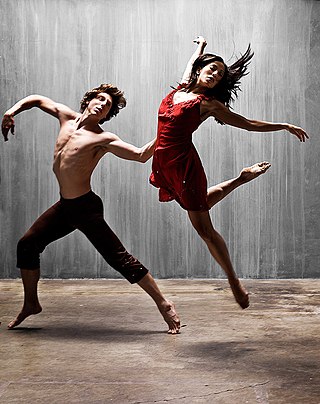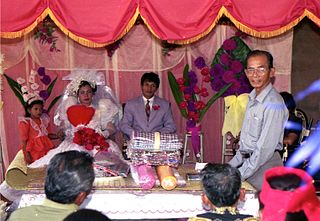Related Research Articles

Dance is an art form, often classified as a sport, consisting of sequences of body movements with aesthetic and often symbolic value, either improvised or purposefully selected. Dance can be categorized and described by its choreography, by its repertoire of movements or by its historical period or place of origin. Dance is typically performed with musical accompaniment, and sometimes with the dancer simultaneously using a musical instrument themselves.

Japanese traditional dance describes a number of Japanese dance styles with a long history and prescribed method of performance. Some of the oldest forms of traditional Japanese dance may be among those transmitted through the kagura tradition, or folk dances relating to food producing activities such as planting rice and fishing, including rain dances. There are large number of these traditional dances, which are often subfixed -odori, -asobi, and -mai, and may be specific to a region or village. Mai and odori are the two main groups of Japanese dances, and the term buyō (舞踊) was coined in modern times as a general term for dance, by combining mai (舞) and odori (踊).

Hula is a Hawaiian dance form expressing chant (oli) or song (mele). It was developed in the Hawaiian Islands by the Native Hawaiians who settled there. The hula dramatizes or portrays the words of the oli or mele in a visual dance form.
Samba is a lively dance of Afro-Brazilian origin in 2/4(2 by 4) time danced to samba music.

Savaiʻi is the largest and highest island both in Samoa and in the Samoan Islands chain. The island is also the sixth largest in Polynesia, behind the three main islands of New Zealand and the Hawaiian Islands of Hawaii and Maui. While it is larger than the second main island, Upolu, it is significantly less populated.

The Music of Samoa is a complex mix of cultures and traditions, with pre- and post-European contact histories. Since American colonization, popular traditions such as rap and hip hop have been integrated into Samoan music.

A lavalava, sometime written as lava-lava, also known as an 'ie, short for 'ie lavalava, is an article of daily clothing traditionally worn by Polynesians and other Oceanic peoples. It consists of a single rectangular cloth worn similarly to a wraparound skirt or kilt. The term lavalava is both singular and plural in the Samoan language.
The traditional culture of Samoa is a communal way of life based on Fa'a Samoa, the unique socio-political culture. In Samoan culture, most activities are done together. The traditional living quarters, or fale (houses), contain no walls and up to 20 people may sleep on the ground in the same fale. During the day, the fale is used for chatting and relaxing. One's family is viewed as an integral part of a person's life. The aiga or extended family lives and works together. Elders in the family are greatly respected and hold the highest status, and this may be seen at a traditional Sunday umu.

Samoans or Samoan people are the indigenous Polynesian people of the Samoan Islands, an archipelago in Polynesia, who speak the Samoan language. The group's home islands are politically and geographically divided between the Independent State of Samoa and American Samoa, an unincorporated territory of the United States of America. Though divided by national border, the culture and language are the same.
Polynesian culture is the culture of the indigenous peoples of Polynesia who share common traits in language, customs and society. The development of Polynesian culture is typically divided into four different historical eras:

Dance in Kiribati includes various styles unique to the island nation. The uniqueness of Kiribati dance when compared with other forms of Pacific Islands dance is its emphasis on the outstretched arms of the dancer and the sudden birdlike movement of the head. The Frigate bird on the Kiribati flag refers to this bird-like style of Kiribati dancing. Most dances are in the standing or sitting position with movement limited and staggered.

Ukrainian dance mostly refers to the traditional folk dances of the Ukrainians as an ethnic group, but may also refer to dances originating from the multiple other ethnic groups within Ukraine.

Dance in Thailand is the main dramatic art form in Thailand. Thai dance can be divided into two major categories, high art and low art.

Dance in Burma can be divided into dramatic, folk and village, and nat dances, each having distinct characteristics. Although Burmese dance resemble the traditional dancing style of its neighbors, in particular [Dance in Cambodia ], it retains unique qualities that distinguish it from other regional styles, including angular, fast-paced and energetic movements and emphasis on pose, not movement.

A puppet is an object, often resembling a human, animal or mythical figure, that is animated or manipulated by a person called a puppeteer. Puppetry is an ancient form of theatre which dates back to the 5th century BC in Ancient Greece.

The architecture of Samoa is characterised by openness, with the design mirroring the culture and life of the Samoan people who inhabit the Samoa Islands. Architectural concepts are incorporated into Samoan proverbs, oratory and metaphors, as well as linking to other art forms in Samoa, such as boat building and tattooing. The spaces outside and inside of traditional Samoan architecture are part of cultural form, ceremony and ritual.
The Maulu'ulu is an indigenous dance performed by the Samoan people. Contemporary ma'ulu'ulu compositions and choreographies are generally performed by female dancers, although some villages have a tradition of men and women dancing together. The maulu'ulu was one of several dance forms and choral song styles that were brought into the Kingdom of Tonga through cultural diffusion in the late nineteenth century. Considerable divergence of technique and choreography now differentiate the Samoan maulu'ulu from the Tongan Ma'ulu'ulu, although their common origin continues to be celebrated.
The Fa'ataupati is a dance indigenous to the Samoans. In English it is simply the "Samoan Slap Dance". It was developed in Samoa in the 19th century and is only performed by males.

The ʻava ceremony is one of the most important customs of the Samoa Islands. It is a solemn ritual in which a ceremonial beverage is shared to mark important occasions in Samoan society. The Samoan word ʻava is a cognate of the Polynesian word kava associated with the kava cultures in Oceania. Both terms are understood in Samoa.

The Pamona people is an ethnic group of Indonesia. They inhabit almost the entire Poso Regency, parts of Tojo Una-Una Regency and parts of North Morowali Regency, Central Sulawesi; in fact there are some even in East Luwu Regency of South Sulawesi, whereas a small remainder lives in other parts of Indonesia. The ancestors of the Pamona people originally came from the land of Salu Moge because they were once from the mountains which is far from the central governance thus they were brought down by Macoa Bawalipu of Wotu, East Luwu Regency to be nearer to the central governance, which is the surrounding region of Mangkutana. But it was until a revolt by the DI/TII rebellion broke out that they spread to Central Sulawesi and to other regions. If there are Pamona people in certain regions, then it is common that a Rukun Poso is formed there, which serves as a means of a group of people from a common ethnic background to engage in various activities within the region. Almost all of the Pamona people practices Christianity. Christianity came into the region at the end of the 19 century and until today it is widely accepted as the religion of the people. Today, all churches of common denomination are grouped under the Central Sulawesi Christian Church headquartered in Tentena, Poso Regency, Central Sulawesi, Indonesia. A large part of the common folk uses Pamona and Indonesian language that is mixed with the local slang. The Pamona people are usually farmers, government officials, pastors, entrepreneurs and so on.
References
- ↑ Jennifer Radakovich (August 2004). MOVEMENT CHARACTERISTICS OF THREE SAMOAN DANCE TYPES: MA'ULU'ULU, SASA AND TAUALUGA (MA). University of Hawaii. Retrieved 6 January 2023.